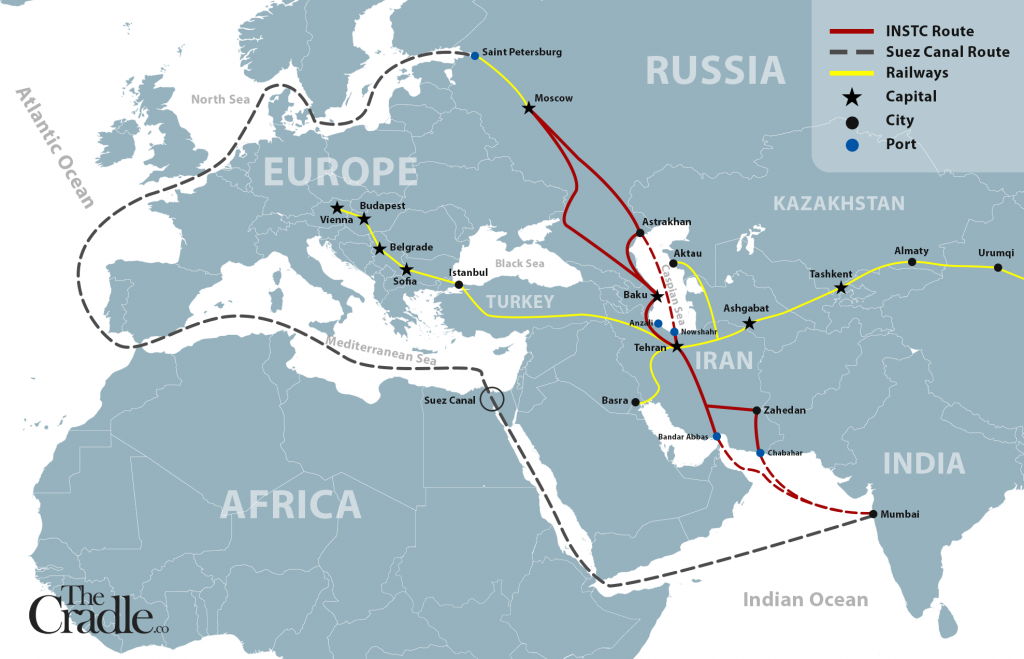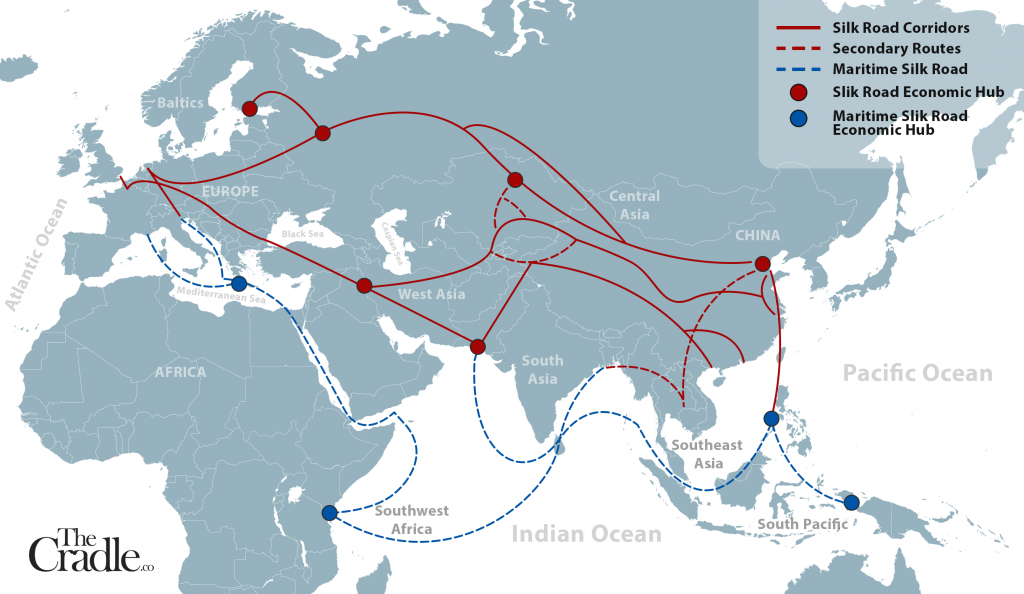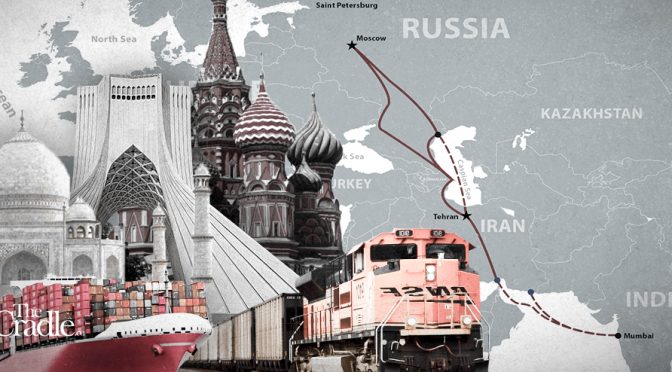No longer just an ‘alternative route’ on a drawing board, the International North South Transportation Corridor (INSTC) is paying dividends in a time of global crisis. And Moscow, Tehran and New Delhi are now leading players in the Eurasian competition for transportation routes.
Tectonic shifts continue to rage through the world system with nation-states quickly recognizing that the “great game” as it has been played since the establishment of the Bretton Woods monetary system in the wake of the second World War, is over.
But empires never disappear without a fight, and the Anglo-American one is no exception, overplaying its hand, threatening and bluffing its way, right to the end.
End of an order
It seems no matter how many sanctions the west imposes on Russia, the victims most affected are western civilians. Indeed, the severity of this political blunder is such that the nations of the trans-Atlantic are heading towards the greatest self-induced food and energy crisis in history.
While the representatives of the “liberal rules-based international order” continue on their trajectory to crush all nations that refuse to play by those rules, a much saner paradigm has come to light in recent months that promises to transform the global order entirely.
The multipolar solution
Here we see the alternative security-financial order which has arisen in the form of the Greater Eurasian Partnership. As recently as 30 June at the 10th St Petersburg International Legal Forum, Russian President Vladimir Putin described this emerging new multipolar order as:
“A multipolar system of international relations is now being formed. It is an irreversible process; it is happening before our eyes and is objective in nature. The position of Russia and many other countries is that this democratic, more just world order should be built on the basis of mutual respect and trust, and, of course, on the generally accepted principles of international law and the UN Charter.”
Since the inevitable cancellation of western trade with Russia after the Ukraine conflict erupted in February, Putin has increasingly made clear that the strategic re-orientation of Moscow’s economic ties from east to west had to make a dramatically new emphasis on north to south and north to east relations not only for Russia’s survival, but for the survival of all Eurasia.
Among the top strategic focuses of this re-orientation is the long overdue International North South Transportation Corridor (INSTC).
On this game-changing mega-project, Putin said last month during the plenary session of the 25th St Petersburg International Economic Forum:
“To help companies from other countries develop logistical and cooperation ties, we are working to improve transport corridors, increase the capacity of railways, trans-shipment capacity at ports in the Arctic, and in the eastern, southern and other parts of the country, including in the Azov-Black Sea and Caspian basins – they will become the most important section of the North-South Corridor, which will provide stable connectivity with the Middle East and Southern Asia. We expect freight traffic along this route to begin growing steadily in the near future.”
The INSTC’s Phoenix Moment
Until recently, the primary trade route for goods passing from India to Europe has been the maritime shipping corridor passing through the Bab El-Mandeb Strait linking the Gulf of Aden to the Red Sea, via the highly bottlenecked Suez Canal, through the Mediterranean and onward to Europe via ports and rail/road corridors.
Following this western-dominated route, average transit times take about 40 days to reach ports of Northern Europe or Russia. Geopolitical realities of the western technocratic obsession with global governance have made this NATO-controlled route more than a little unreliable.

Despite being far from complete, goods moving across the INSTC from India to Russia have already finished their journey 14 days sooner than their Suez-bound counterparts while also seeing a whopping 30 percent reduction in total shipping costs.
These figures are expected to fall further as the project progresses. Most importantly, the INSTC would also provide a new basis for international win-win cooperation much more in harmony with the spirit of geo-economics unveiled by China’s Belt and Road Initiative (BRI) in 2013.
Cooperation not competition
Originally agreed upon by Russia, Iran and India in September 2000, the INSTC only began moving in earnest in 2002 – albeit much more slowly than its architects had hoped.
This 7,200 km multimodal megaproject involves integrating several Eurasian nations directly or indirectly with rail, roads and shipping corridors into a united and tight-knit web of interdependency. Along each artery, opportunities to build energy projects, mining, and high tech special economic zones (SEZs) will abound giving each participating nation the economic power to lift their people out of poverty, increase their stability and their national power to chart their own destinies.
Beyond the founding three nations, the other 10 states who have signed onto this project over the years include Armenia, Georgia, Turkey, Azerbaijan, Kazakhstan, Belarus, Tajikistan, Kyrgyzstan, Oman, Syria and even Ukraine (although this last member may not remain on board for long). In recent months, India has officially invited Afghanistan and Uzbekistan to join too.
While western think tanks and geopolitical analysts attempt to frame the INSTC as an opponent to China’s BRI, the reality is that both systems are extremely synergistic on multiple levels.

Unlike the west’s speculation-driven bubble economy, both the BRI and INSTC define economic value and self-interest around improving the productivity and living standards of the real economy. While short term thinking predominates in the myopic London-Wall Street paradigm, the BRI and INSTC investment strategies are driven by long-term thinking and mutual self-interest.
It is no small irony that such policies once animated the best traditions of the west before the rot of unipolar thinking took over and the west lost its moral compass.
An integrated alternative
The INSTC’s two major bookends are the productive zone of Mumbai in India’s Southeast region of Gujarat and the northern-most Arctic port of Lavna in Russia’s Kola Peninsula of Murmansk.
This is not only the first port constructed by Russia in decades, but when completed, will be one of the world’s largest commercial ports with an expected capacity to process 80 million tons of goods by 2030.
The Lavna Port is an integral part of Russia’s Arctic and Far East Development vision and is a central piece to Russia’s current Comprehensive Plan for Modernization and Expansion of Main Infrastructure and its Northern Sea Route which is expected to see a five-fold increase of Arctic freight traffic over the coming years. These projects are integrally linked to China’s Polar Silk Road.
Between these bookends, the INSTC moves freight from India into Iran’s Port of Bandar Abbas where it is loaded onto double-tracked rail to the Iranian city of Bafq and then to Tehran before coming to the Anzali Port on the southern Caspian Sea.
‘Be like water’
Because the INSTC is based on a flexible design concept capable of adapting to a changing geopolitical environment (very much like the BRI), there are a multitude of connecting lines that branch off the main North-South artery before goods make it to the Caspian Sea.
These include an eastern and western corridor branching off from the city of Bafq towards Turkey and thence Europe via the Bosporus and also eastward from Tehran to Turkmenistan, Uzbekistan, Kazakhstan and thereafter into Urumqi in China.
Railway is still relevant
From the Anzali Port in the north of Iran, goods may travel by the Caspian Sea towards Russia’s Astrakhan Port where it is then loaded onto trains and trucks for transport to Moscow, St Petersburg and Murmansk. Inversely goods may also travel over land to Azerbaijan where the 35 km Iran Rasht-Caspian railway is currently under construction with 11 km completed as of this writing.
Once completed, the line will connect the Port of Anzali with Azerbaijan’s Baku, offering goods a chance to either continue onwards to Russia or westward toward Europe. A Tehran-Baku rail route already exists.
Additionally, Azerbaijan and Iran are currently collaborating on a vast $2 billion rail line connecting the 175 km Qazvin-Rasht railway which began operations in 2019 with a strategic rail line connecting Iran’s Rasht port on the Caspian to the Bandar Abbas Complex in the south (to be completed in 2025). Iran’s Minister of Roads and Urban Development Rostam Ghasemi described this project in January 2022 saying:
“Iran’s goal is to connect to the Caucasus, Russia, and European countries. For this purpose, the construction of the Rasht-Astara railway is in the spotlight. During the Iranian president’s visit to Russia, discussions were conducted in this regard, and construction of the railway line is expected to begin soon with the allocation of needed funds.”
In recent months, India’s Prime Minister Narendra Modi has lobbied to incorporate the joint Iran-India built Chabahar Port into the INSTC which will likely occur since another 628 km rail line from the port to the Iranian city of Zahedan is currently under construction.
Once completed, goods will easily move onward to the city of Bafq. While some critics have suggested that the Chabahar Port is antagonistic to Pakistan’s Gwadar Port, Iranian officials have constantly referred to it as Chabahar’s twin sister.
Since 2014, a vast rail and transportation complex has grown around the co-signers of the Ashkabat Agreement (launched in 2011 and upgraded several times over the past decade). These rail networks include the 917.5 km Iran-Turkmenistan-Kazakhstan route launched in 2014, and Turkmenistan-Afghanistan-Tajikistan rail/energy project launched in 2016 which is currently seeing extensions that could easily go into Pakistan.
In December 2021, the 6540 km Islamabad to Istanbul rail line (via Iran) recommenced operations after a decade of inaction. This route cuts the conventional sea transit route time of 21 days by half. Discussions are already underway to extend the line from Pakistan into China’s Xinjiang Province linking the INSTC ever more closely into the BRI on yet another front.

Finally, June 2022 saw the long-awaited unveiling of the 6108 km Kazakhstan-Iran-Turkey rail line which provides an alternative route to the under-developed Middle Corridor. Celebrating the inaugural 12 day voyage of cargo, Kazakhstan’s President Kasym-Jomart Tokayev stated: “Today, we welcomed the container train, which left Kazakhstan a week ago. Then it will go to Turkey. This is a significant event, given the difficult geopolitical conditions.”
Despite the fact that the INSTC is over 20 years old, global geopolitical dynamics, regime change wars, and ongoing economic warfare against Iran, Syria and other US target states did much to harm the sort of stable geopolitical climate needed to emit large scale credit requisite for long term projects like this to succeed.
Caspian Summit Security breakthroughs
As proof that necessity truly is the mother of invention, the systemic meltdown of the entire post-WW2 edifice has forced reality to take precedence over the smaller-minded concerns that kept the diverse nations of Sir Halford John Mackinder’s “World Island” from cooperating. Among these points of endless conflict and stagnation which has upset great economic potential over the course of three decades, the Caspian zone stands out.
It is in this oil and natural gas rich hub that the five Caspian littoral states (Russia, Iran, Azerbaijan, Kazakhstan and Turkmenistan) have found a power to break through on multi-level security, economic and diplomatic agreements throughout the June 29-30, 2022 Sixth Caspian Summit in Ashgabat, Turkmenistan.
This summit placed a high priority on the INSTC with the region becoming both a north-south and east-west transportation hub. Most importantly, the leaders of the five littoral states made their final communique center around the region’s security since it is obvious that divide-to-conquer tactics will be deployed using every tool in the asymmetrical warfare tool basket going forward.
Chief among the agreed-upon principles were indivisible security, mutual cooperation, military cooperation, respect for national sovereignty, and non-interference. Most importantly, the banning of foreign military from the land and waters of the Caspian states was firmly established.
While no final agreement was reached over the disputed ownership of resources within the base of the Caspian, the stage was set for harmonization of partner states’ security doctrines, a healthy environment was established for the second Caspian Economic Summit which will take place in Autumn of this year and which will hopefully resolve many of the disputes pertaining to Caspian resource ownership.
Although geopolitical storms continue to intensify, it is increasingly clear that only the multipolar ship of state has demonstrated the competence to navigate the hostile seas, while the sinking unipolar ship of fools has a ruptured hull held together by little more than chewing gum and heavy doses of delusion.


